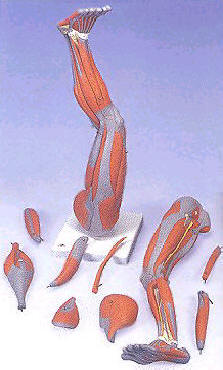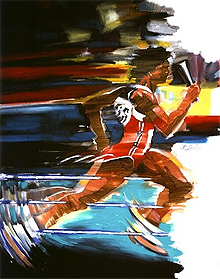인간은 생물학적으로 시속 64km까지 달릴 수 있다는(be biologically capable of running at 64kilometers per hour) 연구 결과가 나왔다. 누가 됐든 세계에서 가장 빠르다는 우사인 볼트(23·자메이카)보다 시속 19km 이상 더 빠르게(more than 19 kilometers quicker than the world‘s fastest man Usain bolt) 달릴 수 있다는 것이다.
미국 와이오밍대학의 생체역학 전문가(a biomechanics expert)인 매튜 번들 박사 연구팀은 ’응용 생리학 저널‘(the Journal of Applied Physiology) 최신호에 발표한 논문에서 “인간은 근육수축 스피드(muscle contraction speeds)를 이용해 시속 56~64km의 달리기 속도(running speeds of 56 to 64 kilometers per hour)를 낼 수 있다”고 밝혔다.
말하자면 올림픽과 세계 챔피언(the Olympic and world champion)인 100m 세계기록(9초58) 보유자(the world record holder in the 100 meter sprint) 볼트가 60m에 도달했을 때 6.67초만에 100m 결승선을 통과할(cross the finishing line in a 100 meter sprint in 6.67 seconds) 수 있다는 것이다.
번들 박사 연구팀은 체내 근육이 생물학적으로 움직일 수 있는 가장 빠른 속도를 계산해(by calculating the quickest rate at which muscles in the body can biologically move) 최대한 가능한 달리기 속도를 산출(calculate the ultimate possible running speed)해봤다.
과거 연구들에서는 속도를 내는 데 가장 큰 장애(the main hindrance to speed)로 우리의 팔다리가 땅을 박차고 나갈 때의 힘 중 일부만 이용할 수 있다는(can onlu take a certain amount of force when they strike the ground) 점을 지적해왔다. 하지만 이번 연구에서는 근육수축이 관건이라는(the contraction of our muscles hold the key) 점을 밝혀냈다.
연구팀은 매 발걸음에 의해 지면에 가해지는 힘의 정확한 크기를 기록하기(record precise measurements of the forces applied to the surface with each footfall) 위해 시속 64km 이상의 속도를 낼 수 있는 고속 러닝머신을 사용(use a high-speed treadmill capable of attaining speeds greater than 64 kilometers per hour)했다. 그리고 조사 대상자들에게 여러 자세로 빠른 속도로 달리게(have subjects’ perform at high speeds in different gaits) 했다.
그 결과 한 다리로 최고 속도로 발을 구르면서 지표면에 가해지는 힘(the ground forces applied while hopping on one leg at top speed)은 최고 속도로 앞으로 달려나가는 도중에 적용되는 힘보다 30% 이상 더 큰 것으로(exceed those applied during top-speed forward running by 30 per cent or more) 나타났다.
또 조사 대상자들 다리 내부의 활동성 근육에 의해 생성되는 힘(the forces generated by the active muscles within the limb)이 한 다리로 발을 구르는 자세에서보다 대략 1.5~2배 큰(be roughly 1.5 to 2 times greater in the one-legged hopping gait by the subjects) 것으로 조사됐다.
이 같은 결과는 달리기 속도의 한계치(running speed limits)가 근육섬유 자체의 속도 한계치에 따라 결정된다는(be set by the speed limits of the muscle fibers themselves) 것임을 보여주는 것이다. 다시 말해서 근육섬유 스피드는 달리는 사람의 다리가 얼마나 빨리 힘을 지면에 가해줄 수 있느냐는 한계치를 좌우한다는(set the limit on how quickly the runner‘s limb can apply force to the running surface) 얘기다.

엘리트 단거리 선수가 뛰는 걸음마다 다리 하나에 800~1000파운드(363~454kg)의 최고 힘을 가할 수 있으면(can apply peak forces of 800 to 1000 pounds with a single limb during each sprinting step) 자신의 근육 및 다리의 힘 한계치 또는 그 한계치에 가까운 힘으로 뛴다고들(run at or near the force limits of his or her muscles and limbs) 생각할 것이다.
그러나 사실은 그렇지 않다는 것이다. 달리는 힘이 아무리 크다고 할지라도(despite how large the running forces canbe) 생물학적으로나 이론적으로 보면 인간의 다리는 최고 속도로 앞을 향해 달릴 때의 힘보다 훨씬 더 큰 지표면 힘을 가할 수 있다는(be capable of applying much greater ground forces than those present during top-speed forward running) 얘기다.

